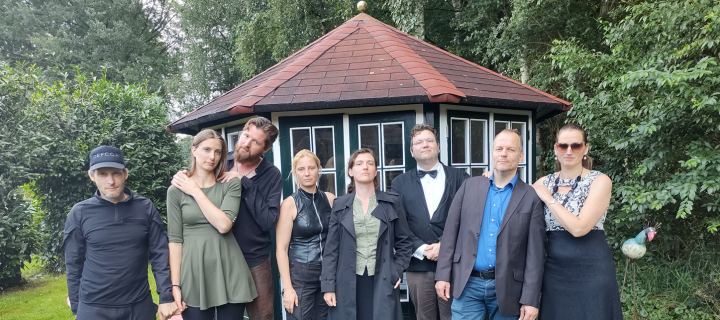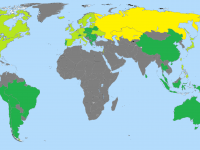After the world started opening up post-pandemic, many of us were eager to reconnect and larp together again. But when restrictions allowed us to meet in small groups, we faced a dilemma: no one had designed a larp ready to be played. With many pre-COVID games cancelled and organizers burnt out from the uncertainty of future lockdowns, we decided to improvise—a full weekend of larping, made up on the spot. It sounds like a wild idea, but surprisingly it worked better than expected. Since then, nine different improv larps have been organized in various countries with more coming up. But what exactly is an improv larp, and why should you consider running or playing one?
The improv larps we’ve run were for a small group of about a dozen people. This small size made the experience adaptable and accessible for the individual needs. Who are we? Rumo played one of the international runs and made this article happen. Gijs thought of the idea 4 years ago and has participated in 10 improv larps so far.
What is an improv larp?
An improv larp is a live-action role-playing event that’s designed and played within the same weekend. There’s no months of pre-planning, intricate world-building, or character sheets written in advance. Everything is created in the moment and on location. This method was purposefully invented to be easy to organize, removing the pressure of long-term preparation. It’s a collaboratively built experience co-created by all the participants together.
While improv larps are designed to minimize effort, they do come with some compromises: Everyone has their own preferences, so naturally, expectation management is very important. There is no thoroughly pre-designed game, so there is a risk that the larp will fail. This process can lead to wonderful experiences full of unexpected larp magic but is no guarantee for it. Sometimes, things don’t go exactly as hoped.
With the tendency of bigger, more thought out designs and the professionalisation of larp organising, improv larp is a way to go the opposite direction (and quite possibly away from orga-burnout): minimal effort, no scripts, no huge logistics, just a group of people with a shared desire to play. While the logistics need to be facilitated, everybody gets to play the game equally. As soon as the larp starts, there is no organiser role.

Photo from Guardians of the Dawn.
All the improv larps so far
There have been 11 improv larps so far. 7 of them were initiated by Gijs van Bilsen, with a small returning group of Dutch players. 2 of them were initiated by Miriam Dik, recruited from a large group of players. And 2 were international events, in Germany and Denmark, initiated by Gijs and with a changing cast of players. These are the names and short descriptions of the events.
Dutch, initiated by Gijs
- For the Order!: About a failed mission by a secret society of eco-activists.
- Everybody Happy?!: About a start-up that has to test its own relationship matching algorithm.
- The Union: About a correctional facility in a collectivistic society, aimed to get rid of individualistic tendencies of the inmates.
- Joa: About a family of flamboyant refugees from the big city, in hiding at a very traditional farmers family in the second world war.
- The Film Crew: About the making of a movie in 80’s Hollywood.
- Guardians of the Dawn: About two families who have been kept apart from society by their fanatical father. The larp started with the father introducing the two families and then disappearing, forcing these two families to live together.
- Dittlinger’s Glory: About the last days of a dictatorial family. They know it is their last day alive, as the rebellious masses will find them in the morning. Only, the masses never come and the family has to deal with all the things they said and did when they thought it was their last day.
Dutch, initiated by Miriam
- 8 days, 8 months, 8 years: About a group of astronauts who were supposed to spend 8 days in the international space station, but ended up spending 8 months. Now, 8 years later there is a reunion for a Netflix documentary, where all the old secrets surface.
- Immortals: A group of immortals needs to pull off a heist in order to decide who gets to be immortal.
International, initiated by Gijs
- The Gay-triarchy: What if there actually was queer revolution? A queer utopia turned dystopia by a government that now oppresses straightness.
- What about Maria: A wholesome larp about strangers who inherit a lovely house together, bonded by their respect and love for the former owner, Maria.
How to facilitate an improv larp
In the following 10 steps we explain how the improv larps have been successfully run.
On Trust and Collaboration
Here are some basics about improv larps that you should keep in mind for it to work: It’s a collaborative process. The whole game is co-created and a lot of decisions are based on compromises. For this to work, you need trust among the players. They don’t necessarily have to know each other before but focus on building trust in the group from the very beginning. It also helps to have a shared vision of the type of larp you want to play. It’s best to have some idea of the type of game you want early on and communicate this to everyone so the group has a common base to start off on.
Proposed schedule
| Step | Time estimate |
| STEP 1: Invite the people for the game you want | 2-6 months before |
| STEP 2: Preparation | 1 month before |
| STEP 3: Pre-meeting | 2 weeks before |
| STEP 4: Coming up with setting | Day 1, 16.00h |
| STEP 5: Deciding on game techniques & safety | Day 1, 21.00h |
| STEP 6: Coming up with characters | Day 1, 23.00h |
| STEP 7: Character relations | Day 2, 10.00h |
| STEP 8: Get dressed and go play | Day 2, 13.00h |
| STEP 9: Half-game calibration | Day 3, 10.00h |
| STEP 10: How it ends | Day 3, 19.00h |
Step 1: Invite the people for the game you want
An improv larp works best with 8-12 people. That’s big enough to have several stories going on at the same time and small enough to do the brainstorming session effectively. You want to invite people who like the same kind of game. You decide if it’s going to be a modern day larp in a luxury villa or a fantasy setting in tents. However, the kind of story that works best is one where the dynamics within the group are interesting enough. Improvising a larp where the problems come from ‘outside’ (such as the horde of orcs that invade a village) will not work as well.
Other types of play such as puzzle plots or rituals that you want to be guided by a game master are not ideal, but possible. In that case, there must also be people who like to take on that facilitating role and can come up with it on the fly.
In terms of which players to invite, aim for herd competence (see Lundqvist 2015): meaning that in the group as a whole, you need to have enough people who bring skills with them that are useful for improvising a larp. Skills like:
- Being able to generate play for others
- Pacing the story
- Knowing what a scene needs
- Play to lift (see Vejdemo 2018).
You can invite people you think are a good addition to the group or let the people who are joining also invite one or more players. In this way, more people already have a relationship of trust with at least one of the participants. Doing this with an established group of friends also works very well.

Photo from Joa.
Step 2: Preparation
The logistical arrangements — date, location, food, clothing and props — are all made together as much as possible.
You first decide on a date with the people you have invited in Step 1. Then you can decide on a location together that fits the financial and geographical needs of all participants. Because it is a small group, many cottages or small group locations are possible. Keep in mind that a good larp location needs some privacy from non-participants such as neighbours.
The chores for the weekend get divided: Everyone who wants to cook prepares a meal, someone does the grocery shopping, and the rest take care of the other tasks such as washing dishes and cleaning up. Cooking or doing the dishes can be done in- or out-of-game, depending on setting and characters.
Instruct everyone to take as many clothes and props as they can manage (especially the people who come with their own car). It’s best to loosely agree on a time period to play in, so that everyone can bring costume pieces accordingly.
Step 3: Pre-meeting
If the people in the group do not know each other well, do an (online) meeting beforehand. People can introduce themselves; they can talk about what kind of game they would like to play and what they are hoping to get out of it. If the expectations are too far apart, you can already pick a direction, so people can get used to the idea or make the conscious choice to drop out. For example, if some people want ‘feel good’, Type 1 fun and others are hoping for more darker Type 2 fun (Nordic Larp Wiki 2023), pick one of those. In the pre-meeting, you can already come up with some ideas for settings, but these meetings are just to get the creative juices flowing. Do not choose the setting yet; leave that to the weekend.
If you have enough time during the weekend, you can also do this on the first day together, but we’ve found a pre-meeting to be very fun and helpful.
Step 4: Coming up with a setting
Take some time for everyone to arrive on the first day. After the group has settled, start a brainstorm session to come up with a setting. Start with wishes and boundaries, e.g., what types of play would you want and what type of play do you absolutely not want? Then start brainstorming. Settings can be short, one sentence larp ideas, like:
- A group of terrorists meet after a failed attack,
- Hippies try to live together unsuccessfully, or
- Astronauts stuck together on a spaceship.
A good brainstorming technique is brainwriting. Write down different ideas for a setting on a piece of paper for a couple of minutes. Then pass around the paper so you can read another person’s ideas and associate more ideas from that. Repeat until you’ve passed all papers around once. This technique works because people have already read most ideas and it doesn’t depend on all participants being verbally quick and spontaneous.
You can also use other creative methods to generate even more ideas. You then select the ideas with the most interest with green stickers for the best and red/orange for a veto/preferably not. Pick the three most popular ideas and have three smaller groups each work out the details of one of these different one sentence ideas into a longer format of what the larp could look like. Include at least:
- Who will be playing,
- Where will the game take place, and
- What is the central conflict of the larp.
Pitch these longer settings to each other. After this process, choose the best one and try to incorporate ideas from other popular ideas to create the full larp you are going to play, e.g., what do you like about this idea?
This process can take 1.5 – 2.5 hours and will probably have a moment where you think, ‘We’ll never get out of this,’ but eventually you’ll get there. Being open to each other and trusting in an idea, even if you don’t quite understand it yet, are important qualities to have. It is good to have someone who is experienced in facilitating group meetings or brainstorming sessions. Having one person keep an eye on time and group dynamics, as well as being able to make decisions, is good.
Step 5: Decide on game techniques and safety
Once you have chosen the setting, you can start detailing it out and think about game techniques. Game techniques that are important are ways to give in-game and off-game input. This can be anything that suits your game, e.g., a flip chart at the toilet for off-game questions and requests, a laptop with in-game news messages on it about how close the police got to the terrorists, or on which emails come in from the investor behind the start-up. You can use anything you know from previously played larps or come up with new mechanics.
Finally, safety in the group is very important. You are even more dependent on your fellow players to make something of the story than in a pre-designed larp. And where you can avoid another player within a larger group, it is much more difficult in a smaller game.
Fortunately, safety in a smaller group is also easier to achieve, especially if you agree in advance what kind of game you want. Talk about what safety mechanics you want to use in your game and adjust them accordingly; as with other techniques it’s easiest to use mechanics from other larps the participants have already played.
Calibrating on the emotional and physical intensity you are aiming for and sharing personal boundaries in the group is important. Talk about how intimate you want the larp to get — especially in regard to sexuality and violence — and what tools you want to use to steer this in-game. For us, the safety discussions also gave us the space to look for more intense play than is possible in many other larps. This is one of the reasons why these larps meant so much to a lot of us.

Photo from The Gaytriarchy.
Step 6: Coming up with characters
After this, you’re going to think about the characters that each would like to play in the setting. As it’s probably late in the evening now, some people will go to bed and others will stay up. People can think about who they want to play on their own or brainstorm together, but it’s important to not decide on any relationships between characters if not everyone is present. For the first ideas of who you want to play, you don’t have write anything down, as the idea might evolve over time. Everybody thinks about characters until after breakfast on the next day, when we move to relations.
Step 7: Character relations
Start with everyone together and have them describe their ideas about their characters. After this you can either do an unstructured period of time where people will develop their mutual relationships in groups of two or three, or you can do a structured exercise. This could for example be standing in a circle of people who point to others to indicate they have an idea about a potential relationship with that person, throwing a ball of yarn to make the relationships visual (see Hernø 2019), writing the relationships down or doing a ‘Hot Seat’ where every person is asked questions about their character.
One example of a structured exercise that we use is based on ‘systemic constellations’ or ‘family constellations’, inspired by the work of Sandy Stiles Andersen (‘Storyweave workshop, Knudepunkt 2023), in which, without speaking, we make a visual representation of the relationships between characters in the room. In short, it goes like this:
- Everyone stands to the side of the room.
- One person steps into the middle of the room. Possibly a character who might be central to the group such as ‘the mother’ or ‘the leader’.
- The next person joins in and determines how they will stand in relation to the first person. Will they stand close by or far off? Facing the other or with their back towards them? Touching or not? Standing up or sitting down, etc.
- After every new person, the people already standing in the middle or the room get a chance to move slightly, if they prefer.
- Continue doing this until everyone is in the middle of the room. This can take quite some time and that’s okay. In the original ‘systemic constellation’ moving around is based on intuition (‘Do I feel like moving?’), but this can also be done based on thoughts like ‘where would my character sit in relation to the others’).
- After everyone is in the middle, have everyone explain why they are there in that specific position and what the main relationships are.
- Then move into talking in twos and threes to flesh out these relationships.
Step 8: Get dressed and go play
You put all the costumes everyone brought in one room and use them to dress up as characters. If everybody takes some things, you end up with heaps of stuff that people can sift through. Usually this leads to fun, communal dressing up, with people getting clothes for each other, using each other as mirror, and getting costume advice.
And then? Then you play! Let your imagination go wild, go with the flow and most of all: have fun!
Step 9: Half-game calibration
About halfway through the game — in our time schedule, just after breakfast on Day 3 — take a moment for off-game calibration. Pause the game and do a quick round: How do you feel about the game? What do you still need today? During the calibration, you also agree on what seems to be a logical moment for the end — before or after dinner — and how you will announce it. We use music that lasts half an hour and builds up to crescendo, so that we know that the final phase has begun. After this process, continue with the game.
Step 10: How it ends
End the game in the way you agreed on in Step 9. Take some time to come down, have some food, maybe debrief however you feel the need to. Have a nice off-game evening together and clean the house together before leaving the next day.
References
Hernø, Nór. 2019. “Your Alternate Relation Narrative (YARN).” Nordiclarp.org, March 29.
Lundqvist, Miriam. 2015. “Making Mandatory Larps for Non Players – Miriam Lundqvist.” Nordic Larp Talks, February 12.
Nordic Larp Wiki. 2023. “Type 2 Fun.” January 26.
Vejdemo, Susanne. 2018. “Play to Lift, not Just to Lose.” In Shuffling the Deck: The Knutpunkt 2018 Color Printed Companion, edited by Annika Waern and Johannes Axner, 143-146. Pittsburgh, PA: Carnegie Mellon University: ETC Press.
This article will also be published in German on teilzeithelden.de and in Dutch on larpplatform.nl.
Cover photo: Photo from For the Order.






